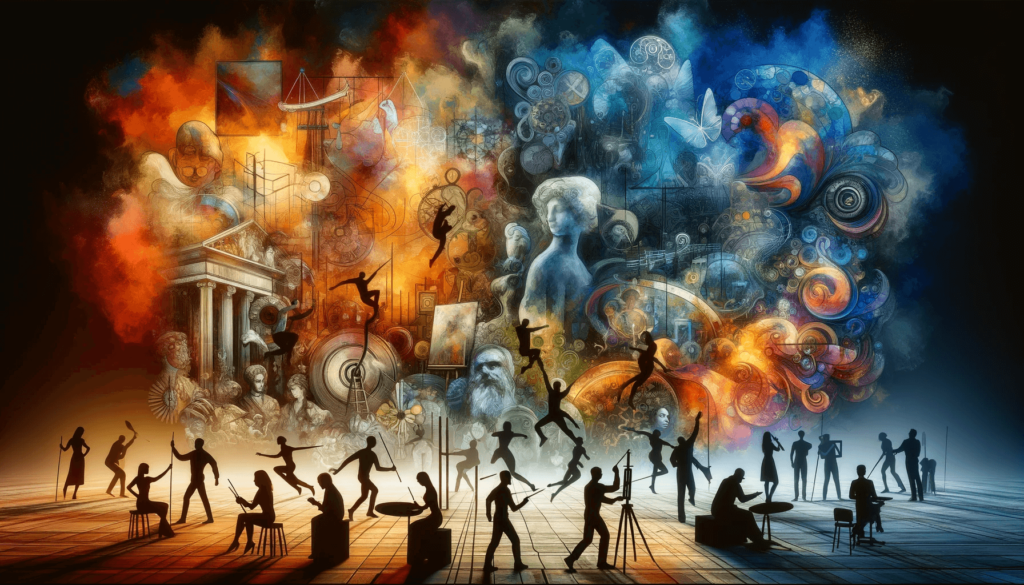
Have you ever wondered what truly defines art? Is it merely a subjective expression of creativity, or is there a concrete classification that separates art from everything else? The concept of art has been a subject of intense debate among philosophers and scholars, with no definitive answer in sight. So, what is considered art? Let’s delve into the complexities of defining art and explore the diverse perspectives that shape our understanding of this timeless form of human expression.
Key Takeaways:
- The definition of art is a controversial and multifaceted topic.
- There are different perspectives on what can be considered art.
- Constraints on defining art include aesthetic properties, historical context, and cross-cultural comprehensibility.
- Contemporary definitions forms of art can be conventionalist, institutional, historical, functional, or hybrid.
- The nature of art is complex and subjective, with interpretations varying based on individual perspectives.
Traditional Art vs Contemporary Art
Traditional art and contemporary art are two distinct categories with contrasting characteristics. Traditional art refers to artworks that adhere to established conventions and techniques, often rooted in cultural or historical contexts. It encompasses various forms such as painting, sculpture, and printmaking. Fine art, a subset of traditional art, is typically created for aesthetic purposes and is regarded as having high cultural value.
Contemporary art, on the other hand, challenges traditional boundaries and embraces experimentation, innovation, and unconventional materials. It reflects the ever-changing nature of society and offers diverse perspectives on cultural, social, and political issues. Contemporary artists often incorporate technology, performance, installation, and multimedia into their works.
One of the key differences between traditional art and contemporary art lies in their intended meanings. Traditional art tends to have a more objective nature, where the artist’s intention and the artwork’s message are often more readily discernible. It seeks to capture beauty, depict historical events, or express religious beliefs. Interpretation may still vary based on individual perspectives and cultural backgrounds, but there is a certain level of consensus on the intended meaning or purpose.
On the other hand, contemporary art is characterized by its subjective nature and open-ended interpretation. It encourages viewers to engage with the artwork and form their own meanings based on personal experiences, emotions, and perspectives. The artist may intentionally leave room for ambiguity or multiple interpretations, inviting dialogue and critical thinking.
Moreover, another distinction between traditional art and contemporary art lies in the division between fine art and applied art. Fine art, as mentioned earlier, is primarily created for aesthetic purposes and is often exhibited in art galleries and museums. It focuses on the artist’s expression, skill, and creativity. Applied art, on the other hand, encompasses art that serves functional purposes and is integrated into everyday objects or designed spaces. Examples include furniture design, textile art, and graphic design.
In conclusion, the comparison between traditional art and contemporary art reveals the evolution of art forms and the subjective nature of artistic expression. While traditional art adheres to established conventions and techniques, contemporary art challenges boundaries and invites open-ended interpretations, reflecting the ever-changing nature of society.
Exploring the Definition of Art
The definition of art has evolved over time, encompassing diverse forms and reflecting contemporary trends. While traditional art forms like painting and sculpture continue to be valued, the artistic landscape has expanded to include innovative mediums and concepts.
According to the Oxford Dictionary, art is described as the expression of human creative skill and imagination, producing works appreciated for their beauty and emotional power. This definition recognizes the subjective nature of art, acknowledging that its value and impact can vary from person to person.
Contemporary art is characterized by its exploration of new forms, challenging traditional boundaries and pushing artistic limits. Artists now utilize various mediums, including photography, digital art, installations, performance art, and more, to convey their ideas and engage viewers.
This diversity of art forms is a testament to the ever-evolving nature of artistic expression. Contemporary art reflects the social and cultural complexities of our time, providing a platform for artists to address a wide range of issues and perspectives.